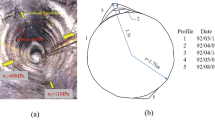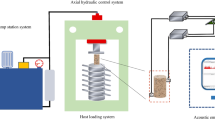Abstract
Water inrush results from excavation unloading and high water pressure coupling. To study the propagation mechanisms of hydraulic fracture and failure mode under unloading conditions, hydraulic fracturing tests and numerical simulations were carried out to study the effects of unloading rate, principal stress difference, and the angle of water-conducting cracks on crack propagation. The results showed that the failure mode is a splitting failure with a single crack under a low unloading rate, while the mode is a multi-crack failure under a high unloading rate. Rock fracture requires higher water pressure under slow unloading conditions, but the rupture time is shorter, and the energy release rate in the moment of failure is greater. During unloading with a low principal stress difference, when the angle between the prefabricated crack and the horizontal direction of the model θ < 45°, the extension direction of hydraulic fracture is mainly controlled by the maximum principal stress direction. When θ > 45°, the growth direction is controlled by the angle of the water diversion fissure. During unloading with a principal stress difference of 0, when θ ≤ 30°, the propagation of hydraulic fracture is more easily controlled by the water conduction fracture. During unloading with a high principal stress difference, when θ ≥ 30°, the maximum principal stress direction controls the propagation. The angle of the water-conducting fracture has little effect on the propagation direction of the main crack. The research in this paper is of great importance in studying the mechanism of water inrush disasters.

















Similar content being viewed by others
Availability of Data and Material
The datasets generated during and/or analyzed during the current study are available from the corresponding author on reasonable request.
Code Availability
All code generated or used during the study are proprietary or confidential in nature and may only be provided with restrictions.
References
Abdollahi S, Madadi M, Ostad-Ali-Askari K (2021) Monitoring and investigating dust phenomenon on using remote sensing science, geographical information system and statistical methods. Appl Water Sci 11:111
Cao J, Shi ST (2023) Evolution Law of Mining-induced Fractures in Shallow Buried Close Coal Seams Mining. Geotech Geol Eng 2023:1–12
Cordero J, Sanchez CM, Quevedo R (2020) Impacts of natural fractures on hydraulic fracturing treatment in all asymptotic propagation regimes. Comput Method Appl M 371:113296
Duan HQ, Xiong S, Yu WB (2023) Numerical simulation study on mechanical and acoustic emission characteristics of coal–rock combined body subjected to cyclic disturbing loading. Geotech Geol Eng 41:783–802
Evbuomwan PO, Yu DM (2011) Theoretical and practical risk assessment method in tunneling. Adv Mater Res 255–260:3953–3957
Fan HY, Li LP, Zong PJ, Liu HL, Yang LJ, Wang J, Yan P, Sun SQ (2023) Advanced stability analysis method for the tunnel face in jointed rock mass based on DFN-DEM. Undergr Space 13:136–149
Gao CL, Li SC, Wang J, Li LP, Lin P (2018) The risk assessment of tunnels based on grey correlation and entropy weight method. Geotech Geol Eng 36:1621–1631
Huang X, Liu QS, Liu KD, Kang YS, Liu XWi, (2015) Laboratory study of deformation and failure of soft rock for deep ground tunneling with TBM. Chin J Rock Mech Eng 34(1):76
Jiang Q, Zhang MZ, Yan F, Su GH, Feng XT, Xu DP, Feng GL (2020) Effect of initial minimum principal stress and unloading rate on the spalling and rockburst of marble: a true triaxial experiment investigation. B Eng Geol Environ 80(2):1617–1634
Li JL, Wang LH, Wang XX, Wang RH, Cheng Z, Li D (2010) Research on unloading nonlinear mechanical characteristics of jointed rock masses. J Rock Mech Geotech 2(4):357–364
Li LP, Hu J, Li SC, Qin CS, Liu HL, Chen DY, Wang J (2021a) Development of a novel triaxial rock testing method based on biaxial test apparatus and its application. Rock Mech Rock Eng 54:1597–1607
Li SC, Liu C, Zhou ZQ, Li LP, Shi SS, Yuan YC (2021b) Multi-sources information fusion analysis of water inrush disaster in tunnels based on improved theory of evidence. Tunn Undergr Sp Tech 113:103948
Liang DX, Jiang ZQ, Zhu SY, Sun Q, Qian ZW (2016) Experimental research on water inrush in tunnel construction. Nat Hazards 81(1):467–480
Liu ZY, Wang SJ, Zhao HY, Li W, Li W, Geng YD, Tao S, Zhang GQ, Chen M (2017) Effect of random natural fractures on hydraulic fracture propagation geometry in fractured carbonate rocks. Rock Mech Rock Eng 51(3):1–21
Liu SL, Zhu QZ, Shao JF (2020) Deformation and mechanical properties of rock: effect of hydromechanical coupling under unloading conditions. B Eng Geol Environ 79(10):5517–5534
Ma G, Zhang F, Liu X, Feng D, Zhang PW (2016) Experimental study of impact of crustal stress on fracture pressure and hydraulic fracture. Rock Soil Mech S2:7
Ren QS, Jiang YD, Wang PP, Wu GJ, Nima ND (2021) Experimental and Numerical Simulation Study of Hydraulic Fracture Propagation during Coalbed Methane Development. Geofluids 3632997:1–12
Sivakumar G, Maji VB (2023) Study on crack growth behaviour in rocks having pre-existing narrow flaws under biaxial compression. Geotech Geol Eng 41:153–188
Talebmorad H, Ostad-Ali-Askari K (2022) Hydro geo-sphere integrated hydrologic model in modeling of wide basins. Sust Wat Resour Man 8:118
Wang S, Li LP, Cheng S, Hu HJ, Zhang MG, Wen T (2020) Risk assessment of water inrush in tunnels based on attribute interval recognition theory. J Cent South Univ 27(2):517–530
Yang WM, Geng Y, Zhou ZQ, Li LC, Ding RS, Wu ZH, Zhai MY (2020) True triaxial hydraulic fracturing test and numerical simulation of limestone. J Cent South Univ 27(10):3025–3039
Yin GZ, Ma B, Liu C, Li MH, Lu J, Yin SY (2019) Effect of loading and unloading rates on mechanical properties and energy characteristics of sandstone under true triaxial stress. J China Coal Soc 44(2):454–462
Zhang JW, Song ZX, Wang SY (2021) Experimental investigation on permeability and energy evolution characteristics of deep sandstone along a three-stage loading path. B Eng Geol Environ 80(2):1571–1584
Zhang DJ, Wang JD, Guo S, Cao JL (2022) Research on the underground water inrush mechanism based on the influence of fault. Geotech Geol Eng 40:3531–3550
Zhao NY, Jiang HF (2021) Mathematical methods to unloading creep constitutive model of rock mass under high stress and hydraulic pressure. Alex Eng J 60(1):25–38
Zhao GB, Guo WB, Kong LY, Zhao Y, Shi QW (2022) Couple effect of joint pore pressure and joint orientations on rock strength based on numerical modeling. Geotech Geol Eng 40:5397–5409
Zhou ZL, Zhao JP, Tan ZS, Zhou XP (2021) Mechanical responses in the construction process of super-large cross-section tunnel: a case study of Gongbei tunnel. Tunn Undergr Sp Tech 115(4):104044
Zhu JQ (2020) Li TZ (2020) Catastrophe theory-based risk evaluation model for water and mud inrush and its application in karst tunnels. J Cent South Univ 27(5):1587–1598
Zou YS, Ma XF, Zhang SC, Zhou T, Li H (2016) Numerical investigation into the influence of bedding plane on hydraulic fracture network propagation in shale formations. Rock Mech Rock Eng 49(9):3597–3614
Acknowledgements
Much of the work presented in this paper was supported by the National Natural Science Foundation of China (51879148, 51991391, 52279104, 42302318), and China Postdoctoral Science Foundation (2022M710081, 2023M732088).
Author information
Authors and Affiliations
Contributions
All authors contributed to the study conception and design; JY: Investigation, Validation, Formal analysis, Methodology, Writing-original draft; MW: Methodology, Data curation, Visualization, Investigation, Project administration; ZZ: Conceptualization, Funding acquisition, Data curation, Visualization; WY: Visualization, Investigation, Supervision, Funding acquisition; SB: Validation, Formal analysis, Conceptualization; DZ: Writing-review & editing, Visualization, Formal analysis; GY: Data Curation; PJ: Supervision, Resources, Software; XJ: Supervision, Software; PL: Resources.
Corresponding authors
Ethics declarations
Conflict of interest
The authors declare that they have no known competing financial interests or personal relationships that could have appeared to influence the work reported in this paper.
Additional information
Publisher's Note
Springer Nature remains neutral with regard to jurisdictional claims in published maps and institutional affiliations.
Rights and permissions
Springer Nature or its licensor (e.g. a society or other partner) holds exclusive rights to this article under a publishing agreement with the author(s) or other rightsholder(s); author self-archiving of the accepted manuscript version of this article is solely governed by the terms of such publishing agreement and applicable law.
About this article
Cite this article
Yang, J., Wang, M., Zhou, Z. et al. Hydraulic Fracture Feature of Rock Under Unloading Based on Test and Numerical Simulation. Geotech Geol Eng 42, 2221–2240 (2024). https://doi.org/10.1007/s10706-023-02670-8
Received:
Accepted:
Published:
Issue Date:
DOI: https://doi.org/10.1007/s10706-023-02670-8




